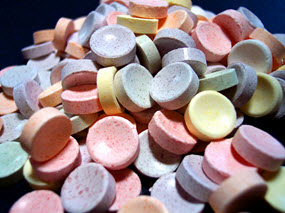
Weathering
![]()
 Before you begin the scientific investigation below, make sure you download the Weathering Scientific Investigation Report. As you complete this scientific investigation, fill in any needed information on the report template. If you need more information about each section of the report, please visit the Developmental Module.
Before you begin the scientific investigation below, make sure you download the Weathering Scientific Investigation Report. As you complete this scientific investigation, fill in any needed information on the report template. If you need more information about each section of the report, please visit the Developmental Module.
This scientific investigation is available below or in a printable version.
Introduction
Weathering is a process that occurs at the Earth’s surface where the rocks of Earth’s crust are exposed to changing effects of the atmosphere. In this laboratory activity, you will investigate how the rate of weathering is affected by surface area.
Objectives
In this scientific investigation, you will:
- define surface area
- compare and contrast methods of physical and chemical weathering
- analyze the rates of chemical and physical reactions
- determine how surface area affects the rate at which rocks weather
Hypothesis
Using the Procedure and Data Collection section below, read through the procedural information for this scientific investigation. Based on your understanding of the procedure, develop your own hypotheses which describe your expected results. You should consider the following question: What is the effect of surface are on the rate of weathering? Record your hypotheses in the Hypothesis section of your Weathering Scientific Investigation Report.
Equipment and Materials
- Roll of Smartie® or Sweet Tarts® candies
- Ruler
- Glass of water
- Plastic Ziploc® bag
- Stopwatch
Procedure and Data Collection
- Obtain two candies from your roll that are identical in color and size and set aside for your experiment.
- Take a sip of water and swish it around your mouth and then spit the water out into a sink.
- Prepare your stopwatch and then place one of the candies selected for the experiment in your mouth. Press start and begin sucking on the candy until the candy dissolves completely in your mouth. Do not chew the candy.
- Record the time in seconds required to dissolve the un-chewed candy in your mouth in the correct column for trial one.
- Take a sip of water and swish it around your mouth and then spit the water out into a sink.
- Prepare your stopwatch and then place the other piece of candy selected for the experiment in your mouth. Press start and then chew the candy two times with your molars then begin sucking on the broken candy until the candy dissolves completely.
- Record total time in seconds required to dissolve the chewed candy in your mouth.
- Repeat steps 1-7 for the five remaining trials.
- Take and average of all six of your trials to be used for comparison.
Data
Use the spaces provided in the Data section of your Weathering Scientific Investigation Report to record your data from this scientific investigation.
Whole Candy Dissolve Time (seconds) |
Broken Candy Dissolve Time (seconds) |
Observations |
|
| Trial 1 | |||
| Trial 2 | |||
| Trial 3 | |||
| Trial 4 | |||
| Trial 5 | |||
| Trial 6 | |||
| Trial 7 |
Data Analysis
In the Data Analysis section of your Weathering Scientific Investigation Report, please answer the following questions in the space provided below each question.
- What is surface area?
- Which candy, the whole or the broken, had the greater surface area? Explain why?
- What kind(s) of weathering did you simulate in this activity?
- Which candy, whole or broken, weathered the fastest?
- Was there a major difference in times between the two trials? Explain why.
Conclusion
Using the Conclusion section of your Weathering Scientific Investigation Report, compose three to four sentences describing an overall conclusion based on your data. Were your hypotheses true or false, and how do you know? Use the data and notes that you collected from your investigation to form your conclusion. Make sure that you include information that you gained from data analysis to support your conclusion.
Experimental Sources of Error
On your Weathering Scientific Investigation Report, provide responses to the following questions: Are there any sources of error? If so, what are they, and what could be done to minimize error?
![]() Once your have completed your Weathering Scientific Investigation Report, please submit your work to the dropbox.
Once your have completed your Weathering Scientific Investigation Report, please submit your work to the dropbox.



